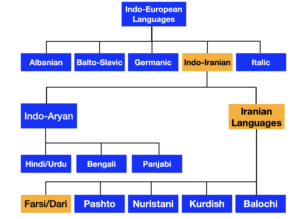Farsi or Parsi, فارسی یا پارسی, (Persion in English) is one of the world’s oldest languages which is currently spoken by millions of people around the world. The largest Farsi speaking nation is Iran with around 50 millions people speaking Farsi as their first language, followed by Afghanistan with around 17 million native Dari speakers, and followed by Tajikistan with about 7 million native speakers.
In Iran it is called Farsi فارسی, and is the only official language there. In Afghanistan the language is called Dari, دری, which means “[language] of the court” as the it used to be mostly used in the court of the King, Royal Palace and in the cities in areas where it’s now spoken. In Tajikistan Farsi is known as Tajiki, and is the only dialect that is written in Russian alphabet.
Mutual intelligibility among the three dialects is high, meaning people from the three countries understand each other easily. Iran is the only country in the world where Farsi is the only official language. In Afghanistan, besides Dari, Pashto is also the official language which is spoken by majority in the country. In Tajikistan, where a Russian minority population reside since the time of the Soviet, Russian is the second official language after Tajiki/Farsi.
But What are some Key Differences between These dialects?
Often times people who speak the same language in the same geographic area (e.g. a city), have the same dialect. But speech and language of people who live in different geographic areas are different, specially if social values and ethnicity and other metrics are to be considered as well. Even within a country people may speak the same language but with different dialect, depending on which city they live in, what social class they belong to, and if ethnicity is different or not.
Afghanistan, Iran and Tajikistan are distinct nations and countries with distinct social and cultural values. Urbanization and developmental differences are a big factor as in the past 50 years Iran and Tajikistan have not been involved in domestic wars but Afghanistan has been. As a result, the literature has remained vivid and alive in some parts more than others. As said, Pashto and Russian are official languages in Afghanistan and Tajikistan which have had their influences on Dari/Tajiki dialects.
As discussed, the other difference is in how the language is called in different countries. It is worth mentioning that contemporary historians and literary writers in Afghanistan believe that the language used be called called Farsi in Afghanistan as well until the 70s, that is when it was changed to Dari based on the geopolitics of the region at that time. Afghanistan was controlled by communist parties and a pro-Western Pahlavi dynasty was ruling in Iran. The communist parties attempted to distance the Afghanistan from Iran, which they did so by propagating and highlighting the differences between the two nations. The fist thing they did was changing Farsi (Parsi-e-Dari) to only Dari in the country. And this trend is continuing to this day.
Despite this, there are numerous evidence in the historic as well as literary writings for each of the names, specially both Farsi and Dari have been used by poets in the past to refer to the same language. And sometimes both Farsi and Dari are used as one combined word as Parsi-i-Dari (Farsi with an “F” is the Arabicised form for Parsi as there is no “P” sound in Arabic.) Some examples of the usage of the names by well-known Farsi poets are below:
فردوسی
بفرمود تا پارسی دری
نوشتند و کوتاه شد داوری
وزان پس چو پیوسته رای آمدش
بدانش خرد رهنمای آمدی
یکی تازه کن قصهء زردهشت
به نظم دری و به خط درشت
خاقانی
دید مرا گرفته لب، آتش پارسی ز تب
نطق من آب تازیان برده به نکتهٔ دری
فرخی سیستانی
دل بدان یافتی از من که نکو دانی خواند
مدحت خواجه آزاده به الفاظ دری
حافظ
ز شعرِ دلکَشِ حافظ کسی بُوَد آگاه
که لطفِ طبع و سخن گفتن دری داند
Farsi and Indo-European Languages

“Historian’s opinion varies about the origin of Aryan people. Some believe they originate from cities surrounding the Baltic Sea, some think they come from surrounding of the Black Sea…. It is said that Aryan people immigrated from there to different directions and that is when the shared language they spoken changed into different languages; which Dari Language is a branch of this Indo-European languages. In academia this branch is called Indo-Iranian and Dari belongs to the Iranian part of it.” (Yameen, 2015).
Sources:
1. Yameen, Mohammad Husain, “Contemporary Grammar of Parsi-e-Dari Language”, Kabul, Maiwand Publishing, 2015 – (Dari)
2. Parthia پارت: https://fa:wikipedia.org
3. Parthian Language زبان پارتی: https://fa:wikipedia.org
4. Sogdian Language زبان سغدی: hhtps://fa:wikipedia.org
5. Ganjoor, Pearlish Persion poems: https://Ganjoor.net
